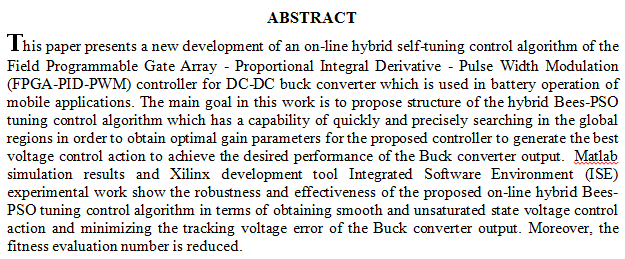
Spin coating technique has been applied in this work to prepared Xerogel films doped with Rhodamine 6G laser dyes. The solid host of laser dye modifies its spectroscopic properties with respect to liquid host. During the spin coating process the dye molecules suffer from changing their environment. The effects of three parameters were studied here: the spinning speed, multilayer coating and formaldehyde addition
Abstract
The aim of this research is to formulate a proposed strategy for developing graduate studies at King Khalid University to support the achievement of the Kingdom's vision (2030). The research used the descriptive survey approach. The research community consisted of all graduate students at King Khalid University. The research was conducted on a random sample included (623) Male and female students, this research relied on the questionnaire as the main tool for collecting its data. The results revealed that the research sample believes that all the proposals included in this research are very important for the development of postgraduate studies at King Khalid University to support the achievement of the K
... Show MoreNew complexes of the type [ML2(H2O)2] ,[FeL2(H2O)Cl] and [VOL2] were M=Co(II),Ni(II) and Cu(II) ,L=4-(2-methyl-4-oxoquinazoline-3(4H)-yl) benzoic acid were synthesized and characterized by element analysis, magnetic susceptibility ,molar conductance ,FT-IR and UV-visible. The studies indicate that the L acts as doubly monodentate bridge for metal ions and form mononuclear complexes. The complexes are found to be octahedral except V(IV) complex is square pyrimde shape . The structural geometries of compounds were also suggested in gas phase by theoretical treatments, using Hyper chem-6 program for the molecular mechanics and semi-empirical calculations, addition heat of formation(?Hf ?) and binding energy (?Eb)for the free ligan
... Show MoreBackground: Enforcement of sustainable and green chemistry protocols has seen colossal surge in recent times, the development of an effective, eco-friendly, simple and novel methodologies towards the synthesis of valuable synthetic scaffolds and drug intermediates. Recent advances in technology have now a more efficient means of heating reactions that made microwave energy. Efforts to synthesize novel heterocyclic molecules of biological importance are in continuation. Microwave irradiation is well known to promote the synthesis of a variety of organic and inorganic compounds. The aim of current study was to conceivea mild base mediated preparation of novel Schiff base of 2-Acetylpheno with trimethoprim drug (H2TPBD) and its complexes w
... Show More (2)
(2)
 (1)
(1)
Coupling reaction of 2-amino benzoic acid with 8-hydroxy quinoline gave bidentate azo ligand. The prepared ligand has been identified by Microelemental Analysis,1HNMR,FT-IR and UV-Vis spectroscopic techniques. Treatment of the prepared ligand with the following metal ions (ZnII,CdII and HgII) in aqueous ethanol with a 1:2 M:L ratio and at optimum pH, yielded a series of neutral complexes of the general formula [M(L)2]. The prepared complexes have been characterized by using flame atomic absorption, (C.H.N) Analysis, FT-IR and UV-Vis spectroscopic methods as well as conductivity measurements. The nature of the complexes formed were studied following the mole ratio and continuous variation methods, Beer's law obeyed over a concentration range
... Show MoreBackground: Diabetic is a chronic systemic disorder of glucose metabolism. That could be diagnosed using fasting and/or random plasma glucose and Glycated Haemoglobin (HbA1c). Several biochemical and microbial alterations of saliva could affect dental caries occurrence and severity among diabetic patients. The aim of the present study was to assess the relation of salivary glucose with severity of dental caries and Mutans Streptococci, among uncontrolled and controlled diabetic groups in comparison with non-diabetic control group. Materials and Methods: The total sample composed of adults aged (18-22) years. Divided into 25 uncontrolled diabetic patients (HbA1c > 7), 25 controlled diabetic patients (HbA1c ≤ 7), in addition to 25 no
... Show MoreThe Manganese doped zinc sulfide nanoparticles of the cubic zinc blende structure with the average crystallite size of about 3.56 nm were synthesized using a coprecipitation method using Thioglycolic Acid as an external capping agent for surface modification. The ZnS:Mn2+ nanoparticles of diameter 3.56 nm were manufactured through using inexpensive precursors in an efficient and eco-friendly way. X-Ray Diffraction (XRD), Scanning Electron Microscopy (SEM) and Fourier Transform Infrared (FTIR) spectroscopy are used to examine the structure, morphology and chemical composition of the nanoparticles. The antimicrobial activity of (ZnS:Mn2+) nanocrystals was investigated by measuring the diameter of inhibition zone using well diffusion mechanism
... Show More (15)
(15)
The δ-mixing of γ-transitions in 70As populated in the 32 70 70 33 Ge p n As (, ) γ reaction is calculated in the present work by using the a2-ratio methods. In one work we applied this method for two cases, the first one is for pure transition and the sacend one is for non pure transition, We take into account the experimental a2-coefficient for previous works and δ -values for one transition only.The results obtained are, in general, in a good agreement within associated errors, with those reported previously , the discrepancies that occur are due to inaccuracies existing in the experimental data of the previous works.
